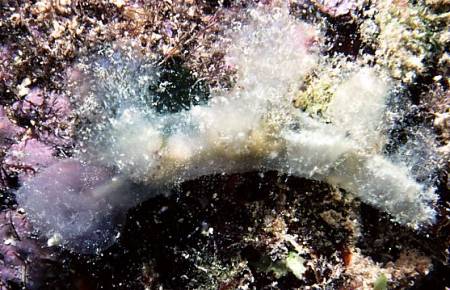
Melibe pilosa
Pease, 1860
Order: NUDIBRANCHIA
Suborder: DENDRONOTINA
Family: Tethydidae
DISTRIBUTION
Hawaiian Islands
PHOTO
on algae-encrusted stones in a meter of water near shore at night. Photo taken Feb. 1991 at Makapu`u, Oahu, Hawaii. Photo: Keoki Stender.
Living animals are translucent white with various amounts of brown pigment, owing to the presence of symbiotic zooxanthellae. Large, isolated spots of dark brown may be present on the cerata. Scattered small spots of opaque white are distributed over much of the body’s surface. The oral hood is entire, circular and of moderate diameter. There are four rows of tentacles along the margin of the oral hood, with the innermost row containing the longest ones. The rhinophore sheath widens near its free end. Several papillae are present along the posterior margin of the sheath, including a multifid papilla at the posterior apex. The perfoliate rhinophores possess 9-11 lamellae. The triangular cerata are arranged in alternating rows with 5-8 cerata per side. The cerata have numerous elongate papillae scattered over their surface. Similar unbranched or branched papillae are present on the notum and sides of the animal. The anus is located immediately anterior to the second ceras on the right side of the body. The nephroduct is directly anterior to the anus. The gonopore is situated ventral to the anteriormost ceras and is surrounded by several conical papillae. The foot is narrow and rounded anteriorly.
Specimens have been found commonly in the Hawaiian Islands, where they inhabit intertidal and shallow water subtidal reef and sand flats. The animals are very cryptic on mixed sand, rock and algal substrata. [from Gosliner, 1987]
See Pease's original description.
References:
• Pease, W.H. (1860) Descriptions of new species of mollusca from the Sandwich Islands. Proc. Zool. Soc. London, 28: 18-36 (part 1), 141-148 (part 2)
• Gosliner, T.M. (1987). Review of the Nudibranch Genus Melibe (Opisthobranchia: Dendronotacea) with descriptions of two new species. The Veliger, 29(4): 400-414
Rudman, W.B., 2003 (October 2) Melibe pilosa Pease, 1860. [In] Sea Slug Forum. Australian Museum, Sydney. Available from http://www.seaslugforum.net/find/melipilo
Related messages
Melibe pilosa from Hawaii
October 17, 2003
From: Keoki Stender

Hi Bill,
Here's a Melibe pilosa from Hawaii to add to the species list. Infrequently seen on algae-encrusted stones in a meter of water near shore at night. Photo taken Feb. 1991 at Makapu`u, Oahu, Hawaii.
Keoki
fishpicshi@yahoo.com
Stender, K., 2003 (Oct 17) Melibe pilosa from Hawaii. [Message in] Sea Slug Forum. Australian Museum, Sydney. Available from http://www.seaslugforum.net/find/11099Thanks Keoki,
I still find some of the large species of Melibe difficult to separate from one another so any help with photos and information is very welcome. At present this species seems to be endemic to the Hawaiian Islands
Best wishes
Bill Rudman
Melbe pilosa - Pease's description
October 17, 2003
From: Bill Rudman
To accompany Keoki's photo of Melibe pilosa, here is Pease's original description. There were no accompanying illustrations.
Elongate, smooth, widest anteriorly, and tapering to a point behind. Sides convexly rounded, and the back arched. Foot linear, grooved, extending the whole length of the body, and acute at both ends. Six pairs of thick tuberculated lobes along the back, the anterior pair opposite, the others alternate to one another, the last at the tip of the body. These lobes are easily deciduous, contracted at their bases, truncated above, convex outside, and flattened on the inner surface. Frontal veil very large, semiglobular, much inflated above; united beneath the head, forming a continuous margin, which is closely fringed. Mouth proboscidiform, and the orifice vertical. Tentacles on the posterior portion of the veil rather remote, small, ovate, closely and transversely lamellated and retractile into long trumpet-shaped sheaths, which are furnished with laciniated appendages. Everywhere with small, soft, branched, tentacular processes. Colour fawn, subtranslucent, more or less clouded with whitish, which under the lens has the appearance of minute dots. Body punctured with brown which are most conspicuous along the flanks. Tubercles on the lobes brown. Foot pale.
These animals were found amongst sea-weed in the upper region of the laminarian zone, and when placed in a basin of water were very active, swimming by suddenly curving the head and tail laterally, so as to nearly touch one another. When slightly disturbed they would cast off one or all of their lobes. The length of their lobes varies much, being in some as large again as in others; they may be consequently reproduced after being cast off. Their foot cannot be used for creeping on a flat surface, but is well adapted for clasping sea-weed. [from Pease, 1860]
• Pease, W.H. (1860) Descriptions of new species of mollusca from the Sandwich Islands. Proc. Zool. Soc. London, 28: 18-36 (part 1), 141-148 (part 2)
Bill Rudman
Rudman, W.B., 2003 (Oct 17) Melbe pilosa - Pease's description. [Message in] Sea Slug Forum. Australian Museum, Sydney. Available from http://www.seaslugforum.net/find/11263